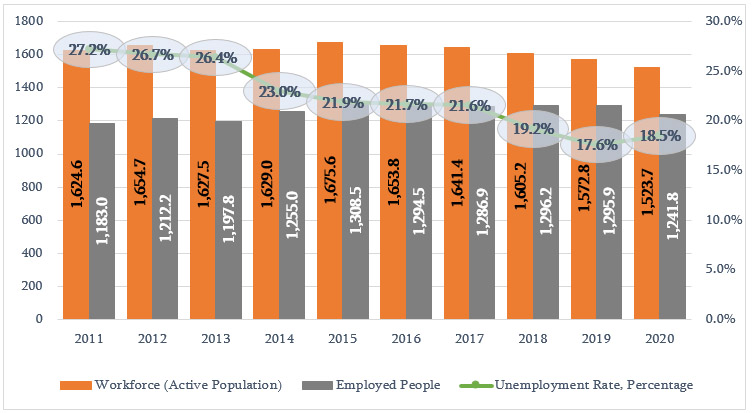Natia Turnava: The unemployment rate increased as compared to 2019 but it is the lowest in the last decade
Verdict: FactCheck concludes that Natia Turnava’s statement is a MANIPULATION.
Resume: The unemployment rate in 2020 increased by 0.9 of a percentage point as compared to 2019 and reached 18.5%. Technically speaking, the lowest level of unemployment in the last decade with the exception of 2019 is indeed in 2020. However, this is explained by the unemployment calculation methodology instead of any positive trends in employment. According to the methodology, a person is considered to be a so-called “discouraged worker” once he stops looking for a job and ends up outside of the workforce and is no longer considered as unemployed. This is why the number of registered unemployed people decreased as compared to the previous years (2011-2018) and not because of job creation.
Employment indicators need to be analysed in order to see the real picture. The number of employed individuals decreased by 54,100 as compared to 2019 and amounts to 1,241,800 which is the lowest figure in 2014-2020. The employment rate in 2020 is 41.1% which is also the lowest figure since 2013.
Natia Turnava ignores employment indicators as well as puts the decreased workforce and the current unemployment rate in a positive light which is delusive.
Analysis
The Minister of Economy and Sustainable Development of Georgia, Natia Turnava, speaking about the 2020 unemployment rate, stated: “Unemployment is a worldwide problem and a result of the pandemic. The unemployment rate increased by 0.9 of a percentage point and reached 18.5%. This is worse as compared to 2019 but I cannot help mentioning that this is the lowest figure in the last decade. This rate is an improvement as compared to 2018.”
FactCheck verified the accuracy of Natia Turnava’s statement.
The unemployment rate in 2020 increased by 0.9 of a percentage point as compared to 2019 and reached 18.5%. Technically speaking, the lowest level of unemployment in the last decade with the exception of 2019 is indeed in 2020. At the same time, the employment rate in 2020 is 41.1% which is the lowest figure since 2013. The relatively lower unemployment rate is stipulated by the decrease in the economically active population (unemployed people looking for jobs).
The unemployment rate is calculated by the unemployed people to the economically active population (workforce) ratio. A workforce comprises employed people as well as unemployed people looking for jobs. In accordance with the methodology of the National Statistics Office of Georgia, if a person ceases looking for a job, he ends up outside of the workforce and is no longer considered as unemployed. These are the so-called “discouraged workers” who leave the ranks of the unemployed although they are not employed. Since 2015, Georgia’s workforce has been decreasing annually. This means that part of the population ended up outside of the workforce and, as a result, unemployment decreased without a growth in employment. The number of employed people decreased by 12,600 in 2016-2019.
Graph 1: Employment and Unemployment in 2011-2020

Source: National Statistics Office of Georgia
The number of employed individuals decreased by 54,100 as compared to 2019 and amounts to 1,241,800 which is the lowest figure since 2013. In the last decade, employment in Georgia peaked in 2015. The number of employees decreased in 2016-2017 and employment increased, in 2018 following a slight decrease again in 2019 (see Graph 1).







